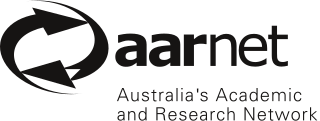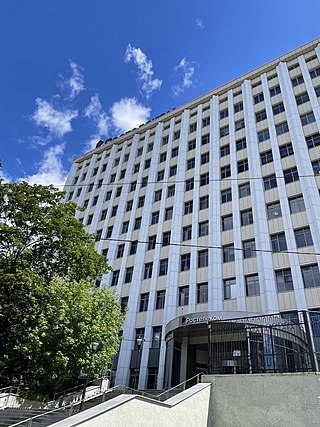
Janet is a high-speed network for the UK research and education community provided by Jisc, a not-for-profit company set up to provide computing support for education. It serves 18 million users and is the busiest National Research and Education Network in Europe by volume of data carried. Previously, Janet was a private, UK-government funded organisation, which provided the JANET computer network and related collaborative services to UK research and education.

A metropolitan area network (MAN) is a computer network that interconnects users with computer resources in a geographic region of the size of a metropolitan area. The term MAN is applied to the interconnection of local area networks (LANs) in a city into a single larger network which may then also offer efficient connection to a wide area network. The term is also used to describe the interconnection of several LANs in a metropolitan area through the use of point-to-point connections between them.
Open Shortest Path First (OSPF) is a routing protocol for Internet Protocol (IP) networks. It uses a link state routing (LSR) algorithm and falls into the group of interior gateway protocols (IGPs), operating within a single autonomous system (AS).

The London Internet Exchange (LINX) is a mutually governed Internet exchange point (IXP) providing peering services and public policy representation to network operators, encompassing over 950 different autonomous systems (ASNs). Established in 1994 in London, LINX operates IXPs in London, Manchester, Scotland, and Wales in the United Kingdom, as well as in Northern Virginia, United States.

The Internet backbone is the principal data routes between large, strategically interconnected computer networks and core routers of the Internet. These data routes are hosted by commercial, government, academic and other high-capacity network centers as well as the Internet exchange points and network access points, which exchange Internet traffic internationally. Internet service providers (ISPs) participate in Internet backbone traffic through privately negotiated interconnection agreements, primarily governed by the principle of settlement-free peering.
The National Science Foundation Network (NSFNET) was a program of coordinated, evolving projects sponsored by the National Science Foundation (NSF) from 1985 to 1995 to promote advanced research and education networking in the United States. The program created several nationwide backbone computer networks in support of these initiatives. It was created to link researchers to the NSF-funded supercomputing centers. Later, with additional public funding and also with private industry partnerships, the network developed into a major part of the Internet backbone.
Internet exchange points are common grounds of IP networking, allowing participant Internet service providers (ISPs) to exchange data destined for their respective networks. IXPs are generally located at places with preexisting connections to multiple distinct networks, i.e., datacenters, and operate physical infrastructure (switches) to connect their participants. Organizationally, most IXPs are each independent not-for-profit associations of their constituent participating networks. The primary alternative to IXPs is private peering, where ISPs directly connect their networks to each other.

AARNet provides Internet services to the Australian education and research communities and their research partners.
The next-generation network (NGN) is a body of key architectural changes in telecommunication core and access networks. The general idea behind the NGN is that one network transports all information and services by encapsulating these into IP packets, similar to those used on the Internet. NGNs are commonly built around the Internet Protocol, and therefore the term all IP is also sometimes used to describe the transformation of formerly telephone-centric networks toward NGN.
The China Education and Research Network is the first nationwide education and research computer network in China. The CERNET project is funded by the Chinese government and directly managed by the Chinese Ministry of Education. It is constructed and operated by Tsinghua University and the other leading Chinese universities.

ATMnet was a regional Internet service provider (ISP) located in San Diego, California, United States. It was formed in 1994 and operated until its purchase by Verio in November 1997 as part of the latter's national roll-up of regional ISPs.

Rostelecom (Ростелеком) is Russia’s largest provider of digital services for a wide variety of consumers, households, private businesses, government and municipal authorities, and other telecom providers. Rostelecom interconnects all local public operators’ networks into a single national network for long-distance service. In other words, if one makes a long-distance call or originates Internet contact to or from Russia, it is likely that Rostelecom is providing part of the service. The company's stock trades primarily on the Moscow Exchange.
EUDRANET, the European Telecommunication Network in Pharmaceuticals, is an IT platform to facilitate the exchange of information between regulatory partners and industry during submission and evaluation of applications. The aim of EUDRANET is to provide appropriate secure services for inter-Administration data interchange and for exchanges between Administrations and industry. EUDRANET is based on the TESTA backbone infrastructure provided by the IDA Programme.
Interreg is a series of programmes to stimulate cooperation between regions in and out of the European Union (EU), funded by the European Regional Development Fund. The first Interreg started in 1989. Interreg IV covered the period 2007–2013. Interreg V (2014–2020) covers all 27 EU member states, the EFTA countries, six accession countries and 18 neighbouring countries. It has a budget of EUR 10.1 billion, which represents 2.8% of the total of the European Cohesion Policy budget. Since the non EU countries don't pay EU membership fee, they contribute directly to Interreg, not through ERDF.

Internet in Russia, or Russian Internet, and sometimes Runet, is the part of the Internet that is related to Russia. As of 2015, Internet access in Russia is available to businesses and home users in various forms, including dial-up, cable, DSL, FTTH, mobile, wireless and satellite.
Delivery of Advanced Network Technology to Europe (DANTE) is a not-for-profit company that plans, builds and operates the consecutive generations of the backbone network that interconnects the national research and education networks (NRENs) in Europe. The organisation is based in Cambridge, United Kingdom and was formed in 1993 as a limited liability company owned by Réseaux Associés pour la Recherche Européenne (RARE). Ownership was transferred to a number of NRENs and government agencies in 1994.

Iceland is among the top countries in the world in terms of Internet deployment and use. 99.68% of Icelanders used in the internet in 2021.
Internet in Tajikistan became present within the country during the early 1990s. Tajikistan had just become independent in 1992, with Emomali Rahmon as the new ruler, when the internet was introduced to the country. Nevertheless, it was after over a decade that the country’s internet became more accessible. The history of the internet’s foundation in Tajikistan extends from 1992 to present-day Tajikistan. By 2009, internet penetration had developed since the initial conception of the internet in Tajikistan and Internet Service Providers (ISPs) had increased in number. In terms of the ISPs, Tajikistan primarily relied upon satellite-based connections using Discovery Global Networks.
All European countries show eGovernment initiatives, mainly related to the improvement of governance at the national level. Significant eGovernment activities also take place at the European Commission level as well. There is an extensive list of eGovernment Fact Sheets maintained by the European Commission.
The Internal Market Information System (IMI) is an IT-based network that links public bodies in the European Economic Area. It was developed by the European Commission together with the Member States of the European Union to speed up cross-border administrative cooperation. IMI allows public administrations at national, regional and local level to identify their counterparts in other countries and to exchange information with them. Pre-translated questions and answers as well as machine translation make it possible for them to use their own language to communicate.








